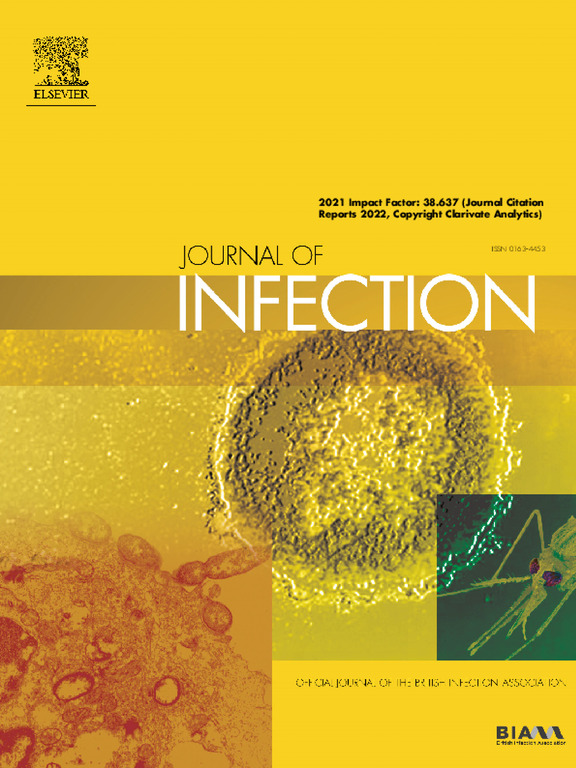Clonal outbreak of Candida vulturna in a paediatric oncology ward in Maranhão, Brazil
IF 14.3
1区 医学
Q1 INFECTIOUS DISEASES
引用次数: 0
Abstract
Objective
To describe an outbreak due to Candida vulturna, a newly emerging Candida species belonging to the Candida haemulonii species complex in the Metschnikowiaceae family.
Methods
In this retrospective cohort study we genotyped 14 C. vulturna bloodstream isolates, occurring in a 4-month-period in paediatric cancer patients in a Brazilian hospital. To prove an outbreak, ITS sequence analysis and whole genome sequencing (WGS) was done. Antifungal susceptibility was performed with the reference CLSI method and the commercial Sensititre YeastOne (SYO) YO10 plates. A control C. vulturna isolate from another region in Brazil was included in all analyses.
Results
MALDI-TOF-MS identified isolates as C. pseudohaemulonii and C. duobushaemulonii albeit with low scores and therefore molecular methods were required for accurate identification. ITS sequence analyses clearly differentiated C. vulturna from other species in the C. haemulonii species complex. WGS proved the presence of a clonal outbreak with C. vulturna involving 14 paediatric patients. Antifungal susceptibility testing (AFST) with two methods showed the isolates had low MICs of commonly available antifungals.
Conclusion
This study describes an outbreak due to the rare yeast C. vulturna, related to C. auris, during a four-month period in patients admitted to a paediatric oncology ward in a Brazilian hospital. In contrast to previous studies the yeast was susceptible to all antifungals and patient outcome was good.
巴西马拉尼昂州一家儿科肿瘤病房爆发了白色念珠菌克隆疫情。
目的Vulturna 是一种新出现的念珠菌,属于 Metschnikowiaceae 家族的 Candida haemulonii 菌种群:在这项回顾性队列研究中,我们对巴西一家医院的儿科癌症患者在 4 个月内的 14 个 Vulturna 血流分离菌株进行了基因分型。为了证明疫情爆发,我们进行了 ITS 序列分析和全基因组测序(WGS)。抗真菌药敏试验采用 CLSI 参考方法和商用 Sensititre YeastOne (SYO) YO10 菌落总数计数板进行。所有分析均包括来自巴西另一地区的对照 C. vulturna 分离物:结果:MALDI-TOF-MS 鉴定出分离物为 C. pseudohaemulonii 和 C. duobushaemulonii,尽管得分较低,因此需要采用分子方法进行准确鉴定。ITS 序列分析将 C. vulturna 与 C. haemulonii 种群中的其他物种明确区分开来。WGS 证明,在 14 名儿科患者中爆发了 C. vulturna 的克隆疫情。采用两种方法进行的抗真菌药敏试验(AFST)显示,分离菌株对常用抗真菌药物的 MIC 值较低:本研究描述了巴西一家医院的儿科肿瘤病房在四个月内爆发的罕见酵母菌 C. vulturna(与 C. auris 相关)疫情。与之前的研究不同的是,该酵母菌对所有抗真菌药都敏感,而且患者的预后良好。
本文章由计算机程序翻译,如有差异,请以英文原文为准。
求助全文
约1分钟内获得全文
求助全文
来源期刊

Journal of Infection
医学-传染病学
CiteScore
45.90
自引率
3.20%
发文量
475
审稿时长
16 days
期刊介绍:
The Journal of Infection publishes original papers on all aspects of infection - clinical, microbiological and epidemiological. The Journal seeks to bring together knowledge from all specialties involved in infection research and clinical practice, and present the best work in the ever-changing field of infection.
Each issue brings you Editorials that describe current or controversial topics of interest, high quality Reviews to keep you in touch with the latest developments in specific fields of interest, an Epidemiology section reporting studies in the hospital and the general community, and a lively correspondence section.
 求助内容:
求助内容: 应助结果提醒方式:
应助结果提醒方式:


